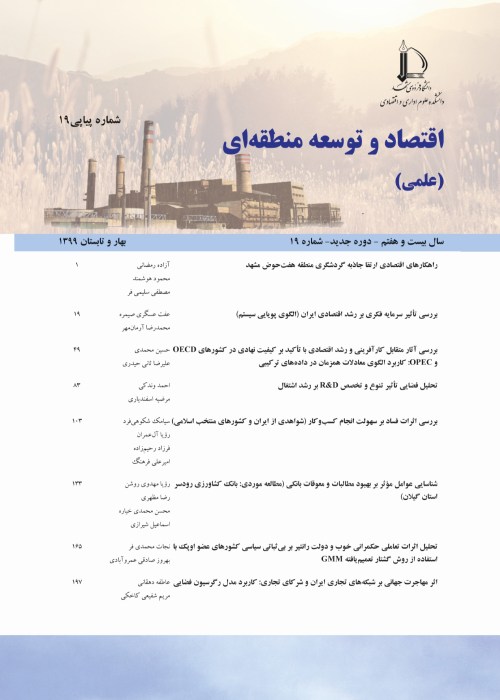Determination of the Integrated Water-Economy-Environment Index for Regional Water Resource Allocations in Iranian Provinces
Sustainable development is defined as a form of development process that meets the current human requirements without affecting the ability of future generations to cover their needs. Water is considered an essential resource for food and industrial productions, environmental protection, and a key irreplaceable requirement to sustainable development. Accordingly, policymaking for water sector in any region requires taking into account the principals of sustainable development and integration in allocation of the water resources. Integrated water resource allocation is usually defined as a process that promotes the coordinated development and allocation of water, land and related resources, in order to meet the resultant economic and social welfare without compromising the sustainability of vital ecosystems. A review of the history of water policymaking and allocation of water resources proves that Iran like many countries around the globe is suffering from a multidimensional complex socio-economic and environmental drought that is the consequence of mismanagement, hasty, and uncoordinated water policymaking as the result of a misunderstanding of sustainable development and integration concepts. A review of studies conducted in Iran indicated that there are still no quantitative and analytical criteria for assessing the situation and decision-making in the form of an integrated system for the allocation of regional water resources. Water policymaking and allocation of resources in Iran is conducted without considering the capability and capacity of water resources in different provinces and also without paying any attention to the inseparable connection between water and other socio-economic, agricultural, technology, transportation, and environmental elements. In order to achieve regional water security as well as to achieve regional sustainability, there is an urgent need to develop an integrated water-economy-environment system as a mechanism for the regional integrated allocation of water resources in Iranian provinces.
2- THEORETICAL FRAMEWORK
One of the solutions to water shortages which is introduced by Allan (1998) for west of Asia was the virtual water strategy which is usually known as "virtual water trade" in the literature. The virtual water trade is originally rooted in Heckscher- Ohlin- Samuelson relative advantage theory. This strategy believed that the main solution to water scarcity is to import grain instead of growing grain regionally. Although the idea of virtual water trading is inherently an economic concept; many economists have criticized the virtual water strategy as fallacious failing to take socio-economic, environmental sustainability into account. In response to the critics, many studies believe that there is an urgent need for an integrated water-economy-environment index system in allocation of regional water resources. This evaluation index system takes into account the co-relationship among various components of the economy, society, resources, technology, transportation, and environment as well.
3-
The purpose of this study was to determine the integrated water-economy-environment index for regional policymaking using a comprehensive fuzzy evaluation system and Shannon entropy weighting method in Iranian provinces. For this purpose, after determination the water-economy-environment index based on the latest theoretical and experimental foundations in the field of water resources, the integrated water-economy-environment index was estimated for 31 Iranian provinces. The integrated water-economy-environment index has five main components including water resources, technology, transportation, economy, society, and environment, respectively. Finally, the radar diagrams and geographic maps were used to analyze the spatial distribution of the total water-economy-environment index and its main components.
4- RESULTS &
According to the results of the study Ardabil, Kerman, South Khorasan, Semnan, Sistan and Baluchestan, Fars, Qazvin, Markazi, and Yazd had slightly poor status in the water resource component. Moreover, from the social perspective of the water-economy-environment index South Khorasan, Zanjan, and Hormozgan were classified as slightly poor while North Khorasan, Kermanshah, and Lorestan were poor provinces. On the other hand, most of the Iranian provinces had slightly poor and average situations in the economic component of regional integrated water-economy-environment index. Besides Ilam and Kohgiluyeh and Boyer Ahmad were identified as slightly poor in the technology and transportation component while South Khorasan, Sistan and Baluchestan, Qazvin, and Kermanshah were classified as slightly poor provinces in the environment component of the integrated water-economy-environment index. In addition, based on the results of the total water-economy-environment index, Gilan, Mazandaran, Chaharmahaal & Bakhtiari, and Khuzestan provinces can be suggested as the most suitable provinces for implementation of the virtual water strategy. In other provinces of the country, depending on the situation of the main components and sub-indicators in each of the dimensions of integrated water- economy-environment index including water resources, technology, transportation, economic, social, and environmental components there is a vital need to adopt an appropriate water policy in consistence with the specific conditions in that province.
5- CONCLUSIONS & SUGGESTIONS
Based on the results of the study the integrated water-economy-environment index can be suggested as an effective instrument for allocation of water resources in Iranian provinces. Virtual water strategy in provinces with scarce water resources can be considered as a potential alternative for facing regional water scarcity in Iranian provinces. Due to the scarcity of water resources and budget constraints as well as various situations in Iranian provinces the integrated water-economy-environment policymaking should be conducted regionally and based on the weakness or strength of each province in water resources, economic, social, technology, and environment components. On the other hand, weak provinces in Iran should prohibit water intensive economic activities and persuade the development of second and third-hand water intensive activities and service sector. Finally, it is recommended to policymakers to use regional integrated water-economy-environment index based on regional components and provincial capacities in Iranian provinces. It is also recommended to researchers to examine more detailed assessments of the integrated water-economy-environment index on longer periods in Iranian provinces.
- حق عضویت دریافتی صرف حمایت از نشریات عضو و نگهداری، تکمیل و توسعه مگیران میشود.
- پرداخت حق اشتراک و دانلود مقالات اجازه بازنشر آن در سایر رسانههای چاپی و دیجیتال را به کاربر نمیدهد.



